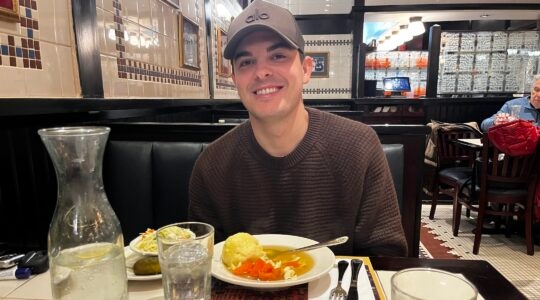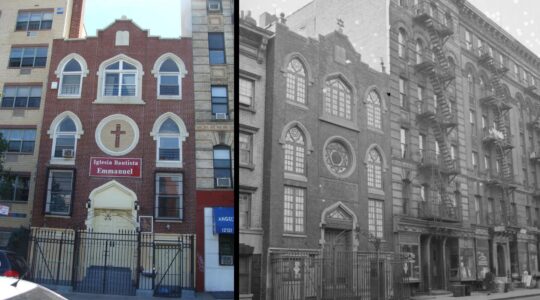Excerpted from Because of Eva
Reprinted with permission of Syracuse University Press
The Blue Numbers
Sometimes, when I was very young, I saw the people with blue numbers on their arms in neighborhood stores or walking down the street carrying bundles. But mainly, I remember seeing them on the New York City subways in the late 1940's, especially on sultry days when hot air blasted in through open windows as the trains roared down dark tunnels, and ceiling fans whirred above us but brought little relief from the sweltering heat.
Usually, the people with blue numbers sat by themselves, with their heads hanging down, and their eyes focused on their shoes or the scuff-marked floor. Even if they were not by themselves – although I remember them only as lonesome and solitary, certainly not in friendly groups chatting and sharing laughs (or even burdens) – they seemed alone just the same. It was easy to spot them in the summertime, when nobody wore coats, and modesty and privacy succumbed to the possibilities of keeping cool. Men loosened their ties, took off their jackets and rolled up their shirt sleeves, and women wore sleeveless cotton dresses or ones with little cap sleeves, and those woeful, god-forsaken people with blue numbers on their arms tried to blend in by dressing like everyone else and forgetting at least for a while that they would always be viewed as aliens who made everyone else anxious and uneasy because the numbers would always set them apart.
By turning my head slowly and glancing sideways, I could see the numbers running along the soft white sides of their forearms like a thin bluish line of railroad tracks, even though Grandma had said it was unkind to stare at people, especially people you did not know, or people with what she called “infirmities.” But I would steal brief glimpses of those poor sad souls with their hang-dog looks, and ruminate about how the blue lines were similar to the veins I traced on my own two arms. “It’s blue, but it’s your blood,” my older brother Jerry explained, gently patting my wrists. “Cut yourself there, and red blood will run out.”
I was no more than three or four when I sensed that something was uncomfortably wrong with “those people” whom I had heard were Jews from faraway Europe. They spoke faintly, if at all, in thick slurry accents that made their words sound gnarly and peculiar. We were Jews, too, but no one in my family knew any of them personally. Even so, their existence lurked around the fringes of my consciousness. Why did they have blue numbers? Had they been painted on? Could they be washed off? Who put them there? And what did they mean? But I would not ask Grandma about this when we returned home.
By the time I was in elementary school, I had picked up a smattering of information about the widespread and wanton murdering of European Jews during World War II. I had overheard snatches of conversations in our apartment house: “Lottie lost everyone;” “He had another family before this one, you know. In Poland. Before….;” “They got out (or they didn’t get out) in time…” Usually, these comments were brief and laden with sighs. On weekend afternoons, I often saw war movies about heroic American GIs fighting sinister Nazis. Afterwards, my dreams were haunted by images of ferocious Doberman pinschers with saliva dripping from teeth like pointed knives, and the sounds of air raid sirens and Nazis banging on doors in the middle of the night or driving on rainswept, cobblestoned streets and searching gutters, sewers and overturned wagons for Jews in hiding. What, exactly, happened to the Jews when they were caught was less clear. I knew they were killed, but how? Fortunately, no one in our family had been murdered by the Nazis; everyone was "already here," in America, was what I was told.
When I was in my teens, I realized that I never saw the people with blue numbers anymore. Had they all died, or had they just figured out how to blend in better with the rest of us? And how had they felt, I wondered, when they rode on subways in the first years after the war, captive to the raging screeches and clangor of the cars, the unremitting clamor running in their heads as the trains veered around bends and pulled in and out of stations? Surely, those noises must have stirred up frantic memories of dazed multitudes pummeled and shoved into stinking cattle cars in which they rode for days without food, water, or light until heavy wooden doors slid open at last to the blinding sight of vicious dogs and bullying German soldiers shouting as strange-looking scrawny people in striped jackets dragged the hesitant passengers off the trains. Sitting alone, on the tan wicker seats, there must have been times when the survivors felt like screaming in horror and pain.
While it’s hard to say, exactly, what provoked my fascination, I now believe that my early awareness of those sorrowful people was triggered by the sea-change in my family’s life. Shortly after the end of World War II, my mother left my father and what she emphatically declared was her “miserable marriage,” taking Jerry and me with her. We moved from our Long Island house into my grandmother Esta’s small apartment in Queens, where we stayed for the rest of my childhood.
Angry battles between my parents, Sunny and Sid, erupted with Vesuvian force as they fought about everything including her coming back home (“Never!”) to his paying child support which was always late, and less than what the Family Court had ordered. The fights went on for years, and added to the agonizing stress of court-ordered visitations that my brother and I endured with Sid….
Back home, with what I would later recognize as Sunny’s characteristic histrionics, she called Sid “Dictator!” “Slave driver!” and “Hitler!”
By the early 1950's, between 20,000 and 30,000 Jews who survived the Holocaust had come to the New York area as displaced persons. Many were concentration camp survivors with blue numbers tattooed on their arms, and in my myopic, child’s eye view of life, I believed that even though they were Jews, they were different than I. Many years would pass before I would solemnly and fully understand that they were not the “other,” and in another time and place, I could have been a Jew like them.
SPONSORED CONTENT
To learn more about the author and purchase this book click here.
The New York Jewish Week brings you the stories behind the headlines, keeping you connected to Jewish life in New York. Help sustain the reporting you trust by donating today.




